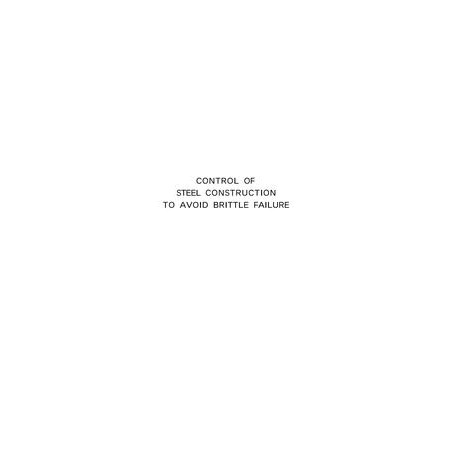No products
 View larger
View larger
Control of Steel Construction to Avoid Brittle Failure
M00010000
New product
Control of Steel Construction to Avoid Brittle Failure
Book by Welding Research Council, 1957
Plasticity Committee of the Welding Research Council, Inc.
In stock
More info
Full Description
Most field erected steel structures are designed on the basis of assumed elastic behavior. I t is, however, impossible to calculate all secondary stresses in such structures, particularly in the regions of stress concentrations. This is true whether the stress concentrations arise as a result of design, or of fabrication techniques. Thus it is tacitly implied that the materials employed will behave, if circumstances require, in a plastic manner by yielding locally. I t has been assumed in the past that materials with good static ductility properties, as determined by elongation and reduction of area in the tensile test, would successfully meet the conditions imposed in service by means of local plastic behavior.
In general, structures designed by conventional methods (assuming elastic behavior) have been satisfactory. Occasionally, however, large steel riveted or welded structures, such as bridges, ships, pressure vessels, and storage tanks, develop fractures instead of yielding locally. Oftentimes such failures are brittle in nature, with little or no plastic deformation, and negligible absorption of energy. The attendant fracture usually travels a t a high velocity, often approaching several thousand feet per second.
Although brittle failure of steel structures is not a new phenomenon, the failure of certain welded ships in World War II placed new emphasis on the need for extending the knowledge of the behavior of steel under conditions of restraint. Much information has since been accumulated. I t is the object of this volume to analyze and assess this information and assemble it for use in conjunction with conventional design procedures.
Fundamentally the conventional design procedure involving stress analysis, i.e., the calculation of stresses for definite loading conditions, permits prediction of the failure of the structure or one of its parts only under the limited conditions of yielding instability, ductile rupture, or fatigue. In complicated structures reliance must be placed on judgment, supplemented with experience in similar structures previously designed. Arbitrary safety factors based on the tensile properties or fatigue properties of the material are usually employed to provide what is considered to be a safe margin of strength in the structure over and above the maximum calculated design stresses. Such conventional procedure, however, is unable to take cognizance of failure by brittle fracture.
Even the best of practical details of design contain some notch effects. In addition there will always be some imperfections in the best of workmanship. In the presence of notches, the breaking strength of the structures, and more important, whether it will fail in a ductile or brittle manner, depends largely upon the capacity of the material a t the root of some critical notch to yield plastically as the load on the structure is increased. At the present time there is no mathematical basis for incorporating in conventional design formulas some measure of the ability of the structural material to undergo local yielding rather than fracture. However, research has added greatly to our engineering knowledge regarding both the conditions which inhibit and promote local yielding (i.e., notch sensitivity) in structural steel. Specifically, this volume endeavors to analyze the research dealing with the notch sensitive properties of structural steel and to summarize the information and data of significance in design and construction. I t is hoped that this information will be useful in supplementing existing knowledge and practices in order to minimize brittle failures.
The volume is divided into three parts. Part I, Materials, presents the basic concepts and mechanisms of notch brittleness, and discusses the pertinent mechanical and metallurgical factors which affect adversely the local plastic behavior of structural materials. Where practicable, the effects of various factors are presented in either summary form or graphically. Where data are inconclusive and concise presentation is not possible, an effort is made to delineate the boundaries of available knowledge.
Part II, Fabrication, deals with fabrication of structural components. Here it is shown how conventional fabrication procedures affect notch ductility of structural materials. Part III, Design, attempts to integrate the information of the first two parts of the book with a view to aiding the designer in selecting and specifying the best suited materials and fabricating procedures. In addition, there is an evaluation of the limits of conventional design procedures, insofar as notch brittleness is concerned, and recommendations for the utilization of available notch-brittle test data.
At the end of the volume is included a glossary of terms related to steel structures and research in notch brittleness. A list of suggested further reading in the areas of (1) theory, (2) research, fabrication, materials, and design, (3) service data, is appended.
Finally, it should be stated th a t this volume was written to aid practicing designers and fabricators. The information set forth here was considered in the realistic light of economic considerations and structural requirements. Wherever possible the authors have endeavored to indicate the economic advantages and penalties associated with various possible procedures and courses of action connected with avoidance of brittle failure in steel structures.

